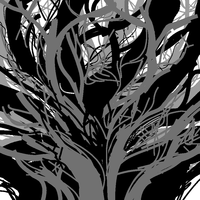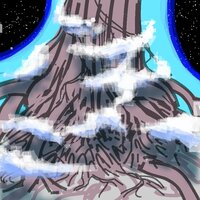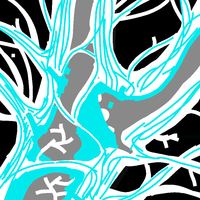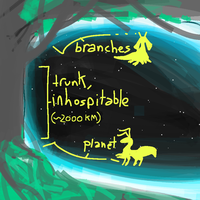Profile
Kiophen
*This species is not finished. This page will update as more information is available about this species.*

Overview
The Kiophen are one of the dominant species of their planet, as well as the primary inhabitant of a supermassive deciduous tree, known as Denden. As adults, Kiophen tend to measure at a height of 2-5 feet tall and range from 20 to 100 pounds in weight. Their most characterizing features include the strange organs ("horns" or "orbs") which grow from their heads, their long lop ears, and their flat, cape-like tails. They are quite diverse in appearance, with many different observed fur colours, patterns, and body types.
Habitat - Denden

Confusingly, Denden is both the name of the Kiophen's home planet as well as the supermassive tree of which they inhabit. To differentiate between the two, the planet and tree will be referred to differently: Den the planet and Denden the tree. Kiophen evolved to live arboreally, with strong limbs and claws to aid in climbing. Their cape-tail assists with gliding. The evolutionary history of the Kiophen is difficult to track due to their permanently arborial lifestyle. [See Kiophen Biology.] It is assumed that the reason why the planet and tree share the same name is because early sapient Kiophen evolved exclusively on the tree, and had no frame of reference that the tree was rooted in a planet. Thus, "denden" was used to refer to their "world".
The reason why all Kiophen refer to Denden as such, all speak the same language, and often share many similarities in their cultures even on opposite ends of Denden is heavily debated but generally believed to be caused by the tree itself, somehow.
Denden's branches span over an area of more than a third of the planet, and has a trunk over 4,000 miles (6,500 km) wide in diameter. If Denden were on the planet Earth, this would make the trunk wider than the contingent United States in width, and the branches would cast shadows over an area larger than Pacific ocean. It cannot be understated how large the tree is. Denden is larger than some planets. Due to the fractalline three-dimensional landscape and sheer scale of the tree, it can be difficult to grasp the idea. Here are some descriptions to attempt to aid with your visualization of the space.
*** {needs cleanup and move this to its own page}
If you stood almost anywhere on Denden, you wouldn't be able to see the sky. Instead, you would see a dense complicated web of branches and leaves of many different sizes that fade back into a thick fog. They curl around and split in unfamiliar angles compared to trees on earth, some of the branches even growing into each other forming closed loops that look like bridges. Most of the smaller branches are going to be around a mile wide. The fog's thickness lets you see up to 40 miles away in any direction on a sunny day.
Despite being so foggy, the light from the sun still pierces deep into all but the most central parts of the tree. The mist emanates a deeply fresh teal glow at noon, and shifts to red-pink in the morning and evening. It goes completely black at night other than a subtle magenta-purple glow coming from the cracks between the bark of the tree itself.
You're sitting on a vertical branch looking out at the arborial-sky. Behind you, the branch could be as wide around as a small Earth country if you're close to the center of Denden. Looking up, it would look like a wall that goes on forever in all directions. Like looking at the ground from a high place on Earth, just rotated 90 degrees. At a location closer to the tip of a branch, it might only be as wide around as a couple farm fields, or several city blocks.
There are still wide, flat areas that can harbor jungles and plains. Thinking about sitting on a tree branch might bring up feelings of precariousness, but the branches of Denden are so wide, you'd have to be running for quite a while until you got close to an edge. Horizontal branches, and especially at the splitting points of branches is where the largest forests grow.
-saddle shaped branches, rivers, lakes, springs, plant life, bugs
***
The atmosphere, water-cycle and perhaps the electromagnetism of the planet are almost entirely maintained/produced by the tree. Different sections of the tree undergo different seasons depending on geographical location and time of year. The seasons are similar to Earth's, with a distinct Summer, Spring, Autumn, and short Winter. The half of the planet opposite of Denden is permanently an uninhabitable tundra. Denden's roots can also be seen piercing through this area into space. Anything else about this area is unknown.
The Kiophen live inside and on the surface of the branches of Denden. The bark of the tree produces a horizontal cracked pattern after aging enough, which provides enough space for walking and building. The areas of branches with the most horizontal cracks tend to have a community settled there. The bark ranges in color depending on the sector of Denden observed, where bark on the trunk and wood closest to the first branching point is white or grey, and bark closer to the tips of branches is highly saturated in color. The hue of the bark correlates with the angle of the branch from the trunk, so looking at the tree from above would look like a color-wheel (if the leaves weren't visible).
✬info about the internal structure of Denden tba
✬info about the other organisms and plants of Denden tba
The leaves of Denden are a useful material for the Kiophen. They grow at the outermost tips of branches, with the largest leaves growing on the outermost layer of the tree's crown. A fully formed leaf ranges from 30 to 60 meters in length, from stem to tip. When a sector of the tree is undergoing Autumn, the leaves shed like deciduous trees on Earth. Due to their size and weight, the leaves are capable of damaging buildings. Due to this, Kiophen communities will opt to dig settlements into the tree, unless the branch is angled enough to allow shelter on the underside. If a community is lucky enough to have a falling leaf lodge itself nearby, a community-wide effort will undergo to retrieve, process, and distribute the leaf's material to citizens of communities in the vicinity. The leaf has a chance of growing a fruit inside, which is valued among all Kiophen for its taste and rarity. The fruit can grow up to 10 meters in diameter and is somewhat like a watermelon in texture, with a powerful citrus flavor.
Biology
Kiophen are intelligent creatures with earthen mammalian characteristics. They have evolved entirely on their own planet, however, so resemblance to Earth mammals are coincidence. Biological life on Denden is not inherently chemically dangerous to Earth life. They can be bipedal, quadrupedal, or hexapodal. The difference between some Kiophen might be so great as to suggest there being multiple species, but even the most contrasting pairs have been shown to successfully reproduce.
A distinct and consistently present feature are the organs protruding from their skulls, referred to as "orbs" (although these organs can form in many distinct shapes other than spheres). The orbs attach directly to the brain with a nerve bundle, and are surrounded with a strong layer of translucent bone-like material, which is then surrounded by a thick transparent layer of skin. The function of these organs are not entirely known even by the Kiophen themselves, but they seem to function as a sensory organ, similar to eyes or ears. The sensory information that orbs are intended to receive is unknown. In some Kiophen communities where members have been observed to exhibit telekinetic abilities, their orbs seem to have a role in this behavior. Kiophen who perform telekinesis will emit light from the inside of their orbs during the act.
Most kiophen have, at least, a minimal ability to glide. Their light bodyweight combined with the lowered gravity in the heights of Denden makes gliding possible even for some larger kiophen with non-conducive body-types. The individuals with bodies highly adapted for gliding have skin that can fold or stretch out, like a flying squirrel. Their tails are wide and flat for this reason; they are dense with muscle that allow it to be stretched out into a large sail.
Kiophen have four main mating types: female which produce eggs, male which produce sperm, vimale which produce vril, and kimales, which do not produce a gamete but have sexual characteristics that aid with gene transfer. These four groups have a range of possible anatomy, meaning that two Kiophen in the same sex-group can be quite different. Kiophen can technically reproduce with any two of the male, female, and vimale groups, however all four are vital to the genetic diversity of the species. Kimales have secondary-sex characteristics which make it possible for them to glide the long distances between branches of Denden, making it possible for gene transfer to occur between otherwise completely isolated communities.
Unlike Earth mammals, Kiophen lay eggs instead of giving live birth.
Reproduction in the quaternary works as follows:
*make a graphic about it
mating triangle . png
*
In some dire circumstances, a member of any sex may undergo an internal change and begin to produce a gamete they normally would not. (e.g., a kimale producing their own eggs, a female producing sperm). This event is triggered only in certain individuals, and is usually in response to a lack of a certain sex in the population. A somewhat similar event can also occur in the event when no kimales are present/have visited an area for an extended period of time. A male or female individual(s) will undergo a metamorphosis, the exact mechanism of which is unknown, and after a period of time lasting several months they will emerge as a kimale with a heightened ability to glide. This process is very important to the long-term survival of smaller isolated communities, as without proper gene flow into a population, they would suffer from inbreeding.
The mating types have minimal sexual dimorphism. its not dimorphic if there's 4 of them lol For the most part it is not possible to determine a Kiophen's sex by their appearance. Kimales tend to be considerably lighter in weight, have wider tails, and tend to have a body-shape that is more conducive to gliding. Physical appearance has too much variance between any random kiophen to make it an accurate metric of determining mating type.
※Kiophen differentiate between sex and gender.
As well as general physical appearance, there is too much variation between even the primary sexual anatomy of members of the same sex-group for sexual gender assignment to be feasible. Since the outward anatomy can be shared between multiple sex-groups, any gender assignment done by that basis would not correlate at all with sex.
There is much physical diversity among Kiophen. Body size and shape has a fair amount of variation; some Kiophen can be very small or quite large. Fur patterns and coloration also varies greatly, with Kiophen having patterned, bright colorful fur in almost any color and combination, as well as more muted solid colors. The most common fur color of a given community correlates with where the community is physically located on Denden. The cause for this is unknown.
Society
Kiophen primarily live in communities carved into branches of Denden, the tree. These communities are quite isolated from any other communities, besides their close neighbors. Kiophen communities are very isolated due to only one sex being able to travel long distances, the state of most current Kiophen technology, as well as the various dangers of Denden.
Many Kiophen religions involve the tree Denden as an element of creation myth, as an omnipotent entity or as the ancestor of all Kiophen.
Kiophen express gender identity differently depending on their community's culture. Kiophen typically don't assign gender to their offspring based on sex as is common in human society. Rather, Kiophen choose their own gender identity. Due to the isolation of communities, gender identity is very varied among different populations and can be hard for an outsider to discern what the differences are. Gendered behavior has been observed to align with biological sex in some communities. In others, gender differences in some populations have been seen to correlate with: social status, role in society, job type, color of fur / orbs / eyes, body-type, personality, interests, preferred food, and others. The number of genders per community can range from zero to several, with a few outlier communities having so many different genders that comprehending their relationship dynamics can be extremely confusing even to other Kiophen.
In the event that an un-gliding Kiophen falls from the tree, they are considered dead, as recovering a lost individual is often beyond their technological capability. In almost all communities, the town will congregate near the last place the lost Kiophen was seen for a funeral ceremony. The friends and family will gather up items that were important to the lost individual and personal good-bye letters and place them in a tight leaf bundle. The ceremony concludes as the bundle is fitted with a parachute and dropped from the tree. It is possible that the fallen Kiophen may survive, if their tail is strong enough to slow their descent and/or they get lucky enough to land near another Kiophen settlement. In the event that a Kiophen survives, they will be accepted into their new home, and a community-wide effort will be made to catch the fallen Kiophen's belongings. It is believed that one reason the funeral practice is so wide-spread is due to fallen Kiophen being one of the few ways culture can be exchanged: if a fallen Kiophen arrives to a new community with their belongings soon after, the new community could adopt the practice of sending off their own fallen with their belongings.





